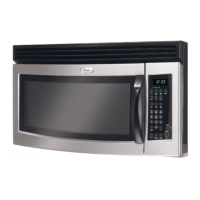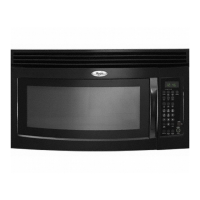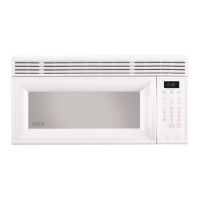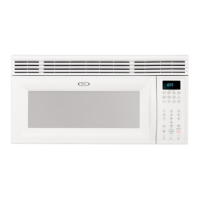What to do if the colon is flashing on my Whirlpool MH3184XPB?
- JJohn JonesAug 2, 2025
If you see a flashing colon on your Whirlpool Microwave Oven, simply press any key to stop the flashing. When in standby mode, the colon should then be steady.
What to do if the colon is flashing on my Whirlpool MH3184XPB?
If you see a flashing colon on your Whirlpool Microwave Oven, simply press any key to stop the flashing. When in standby mode, the colon should then be steady.
What to do if my Whirlpool MH3184XPB Microwave Oven humidity sensor is out of range?
If the humidity sensor on your Whirlpool Microwave Oven is out of range: 1. Unplug the microwave or disconnect the power. 2. Connect a new sensor to the electronic control (at P1). 3. Replace all parts and panels before operating. 4. Plug the microwave back in or reconnect the power. 5. If the problem continues, unplug the microwave or disconnect the power again. 6. Replace the electronic control. 7. Replace all parts and panels before operating. 8. Plug the microwave back in or reconnect the power.
What to do if my Whirlpool MH3184XPB Microwave Oven has a microwave relay failure?
If you're experiencing a microwave relay failure with your Whirlpool Microwave Oven: 1. Unplug the microwave or disconnect the power. 2. Check the wiring to Relay 4903 for short circuits. 3. If the wiring is okay, replace the electronic control. 4. Replace all parts and panels before operating. 5. Plug the microwave back in or reconnect the power.
How to fix a membrane switch failure on a Whirlpool MH3184XPB?
To address a membrane switch failure on your Whirlpool Microwave Oven: 1. Unplug the microwave or disconnect the power. 2. Replace the membrane switch. 3. If the issue remains, replace the electronic control. 4. Replace all parts and panels before operating. 5. Plug the microwave back in or reconnect the power.
Outlines the purpose and aims of the job aid for service professionals.
Provides essential safety guidelines and precautions for using the microwave oven.
Explains the meaning of each character in the model number.
Details the components and meaning of the serial number.
Shows where to find the model and serial number label on the appliance.
Indicates the location of the technical service sheet for the appliance.
Details the dimensions, capacity, finish, and cooking power of the oven interior.
Lists the safety mechanisms like interlock and thermal protectors.
Provides details on the ventilation type, duct size, and airflow.
Lists voltage, wattage, and amperage requirements for the appliance.
Details the dimensions, capacity, and features of the oven interior.
Lists safety features such as interlock and thermal protectors.
Details the type, duct size, and airflow of the ventilation system.
Lists voltage, wattage, and amperage requirements for the appliance.
Specifies necessary clearances and electrical outlet requirements for installation.
Provides the physical dimensions of the microwave oven for installation planning.
Highlights critical safety warnings regarding electrical shock during installation and use.
Explains the importance and procedure for properly grounding the appliance.
Instructions on how to rotate the blower motor for different venting configurations.
Step-by-step guide for installing the microwave oven for wall venting.
Step-by-step instructions for installing the microwave oven for roof venting.
Guidance on physically mounting the microwave oven into the cabinet.
Details on lifting, positioning, and securing the oven to the mounting plate.
Instructions for adjusting the mounting plate if needed during installation.
Identifies the main components and features of the microwave oven.
Diagram showing the turntable, hub, support, and shaft.
Explains the display indicators for status, errors, and time.
Details the function of the START and Add 30 Seconds controls.
Instructions for setting and removing the clock time on the appliance.
How to set, use, and cancel the built-in timer function.
How to control the vent fan speeds and automatic activation.
Instructions for turning the cooktop light on, setting to night, or turning off.
Diagram showing the locations of various internal components within the oven.
Steps to remove and replace the hood lamp socket.
Procedure for disconnecting wires and removing the bottom cover.
Instructions for removing the screws securing the outer cabinet.
Steps to disengage the cabinet from the front panel and remove it.
Procedure for disconnecting wires and removing the cavity thermostat #3.
Steps to remove the four screws and detach the humidity sensor.
How to unlatch and disconnect the wire connector from the fan motor.
Steps to lift and remove the hood exhaust fan motor from the oven.
Steps to remove the lamp holder, including disconnecting wires and rotating the base.
Procedure to remove the stirrer motor by detaching screws and lifting.
Procedure to disconnect wires and remove cavity thermostat #1.
Steps to discharge and remove the motor capacitor.
Steps to remove the top screw and detach the control panel.
Procedure to disconnect ribbon cable and remove the control board.
Procedure to remove the monitor interlock switch.
Steps to remove primary and secondary interlock switches from assembly.
Steps to remove the line fuse from the holder and disconnect wires.
Procedure to disconnect wires and remove the magnetron thermostat.
Steps to remove the cooling fan motor by disconnecting wires and lifting.
Procedure to remove the exhaust fan thermostat.
Steps to discharge capacitor and remove the high-voltage diode.
Procedure to disconnect wires and remove the power resistor.
Steps to discharge capacitor and remove the high-voltage capacitor.
Procedure to disconnect filament wires and remove the magnetron.
Steps to disconnect transformer wires from various components.
Procedure to remove the four screws securing the transformer.
Instructions for removing screws from the bottom cover.
How to disconnect the wire connector from the turntable motor.
Steps to pry the choke cover and remove the top door pin.
Instructions for removing the choke screws from the door frame.
Important safety and procedural notes before testing components.
Procedure for testing various thermostats using an ohmmeter.
How to test the humidity sensor resistance.
Procedure for testing hood exhaust fan motor speeds and resistance.
How to test the stirrer motor using an ohmmeter.
Procedure for testing the motor capacitor's continuity.
How to test the AC line filter coils and resistor with an ohmmeter.
Procedure for testing primary, secondary, and monitor interlock switches.
How to test the line fuse for continuity.
Procedure for testing the cooling fan motor resistance.
How to test the high-voltage diode using a battery and ohmmeter.
Procedure for testing the power resistor's resistance.
How to test the high-voltage capacitor for continuity.
Procedure for testing magnetron filament and chassis resistance.
How to test transformer terminals for continuity and resistance.
Procedure for testing the turntable motor resistance.
Procedure to check the continuity of primary, secondary, and monitor interlock switches.
Diagrams illustrating switch positions for door open/closed states.
Lists error codes, likely failure conditions, and recommended repair procedures.
Explains the display indication after a power failure.
Procedure to initiate and run the self-diagnostic routine for the control panel.
Table mapping control panel keys to display positions during the diagnostic test.
Procedure to test the microwave oven's heating performance with water.
Diagram illustrating the electrical connections and components of the oven.
Key to understanding the symbols used in the wiring diagram.
Diagram showing the circuit for microwave cooking operation.
Circuit diagram for automatic high speed hood exhaust fan operation.
Circuit diagram for manually operating the hood exhaust fan at speeds 4 and 3.
Circuit diagram showing the state when the microwave is plugged in.
Circuit diagram for when the oven door is open and cavity light is on.
Circuit diagram for the cooktop light operating on high setting.
Phone numbers for product specifications, warranty, and technical assistance in the US.
Phone numbers for product specifications, warranty, and technical assistance in Canada.
Outlines the purpose and aims of the job aid for service professionals.
Provides essential safety guidelines and precautions for using the microwave oven.
Explains the meaning of each character in the model number.
Details the components and meaning of the serial number.
Shows where to find the model and serial number label on the appliance.
Indicates the location of the technical service sheet for the appliance.
Details the dimensions, capacity, finish, and cooking power of the oven interior.
Lists the safety mechanisms like interlock and thermal protectors.
Provides details on the ventilation type, duct size, and airflow.
Lists voltage, wattage, and amperage requirements for the appliance.
Details the dimensions, capacity, and features of the oven interior.
Lists safety features such as interlock and thermal protectors.
Details the type, duct size, and airflow of the ventilation system.
Lists voltage, wattage, and amperage requirements for the appliance.
Specifies necessary clearances and electrical outlet requirements for installation.
Provides the physical dimensions of the microwave oven for installation planning.
Highlights critical safety warnings regarding electrical shock during installation and use.
Explains the importance and procedure for properly grounding the appliance.
Instructions on how to rotate the blower motor for different venting configurations.
Step-by-step guide for installing the microwave oven for wall venting.
Step-by-step instructions for installing the microwave oven for roof venting.
Guidance on physically mounting the microwave oven into the cabinet.
Details on lifting, positioning, and securing the oven to the mounting plate.
Instructions for adjusting the mounting plate if needed during installation.
Identifies the main components and features of the microwave oven.
Diagram showing the turntable, hub, support, and shaft.
Explains the display indicators for status, errors, and time.
Details the function of the START and Add 30 Seconds controls.
Instructions for setting and removing the clock time on the appliance.
How to set, use, and cancel the built-in timer function.
How to control the vent fan speeds and automatic activation.
Instructions for turning the cooktop light on, setting to night, or turning off.
Diagram showing the locations of various internal components within the oven.
Steps to remove and replace the hood lamp socket.
Procedure for disconnecting wires and removing the bottom cover.
Instructions for removing the screws securing the outer cabinet.
Steps to disengage the cabinet from the front panel and remove it.
Procedure for disconnecting wires and removing the cavity thermostat #3.
Steps to remove the four screws and detach the humidity sensor.
How to unlatch and disconnect the wire connector from the fan motor.
Steps to lift and remove the hood exhaust fan motor from the oven.
Steps to remove the lamp holder, including disconnecting wires and rotating the base.
Procedure to remove the stirrer motor by detaching screws and lifting.
Procedure to disconnect wires and remove cavity thermostat #1.
Steps to discharge and remove the motor capacitor.
Steps to remove the top screw and detach the control panel.
Procedure to disconnect ribbon cable and remove the control board.
Procedure to remove the monitor interlock switch.
Steps to remove primary and secondary interlock switches from assembly.
Steps to remove the line fuse from the holder and disconnect wires.
Procedure to disconnect wires and remove the magnetron thermostat.
Steps to remove the cooling fan motor by disconnecting wires and lifting.
Procedure to remove the exhaust fan thermostat.
Steps to discharge capacitor and remove the high-voltage diode.
Procedure to disconnect wires and remove the power resistor.
Steps to discharge capacitor and remove the high-voltage capacitor.
Procedure to disconnect filament wires and remove the magnetron.
Steps to disconnect transformer wires from various components.
Procedure to remove the four screws securing the transformer.
Instructions for removing screws from the bottom cover.
How to disconnect the wire connector from the turntable motor.
Steps to pry the choke cover and remove the top door pin.
Instructions for removing the choke screws from the door frame.
Important safety and procedural notes before testing components.
Procedure for testing various thermostats using an ohmmeter.
How to test the humidity sensor resistance.
Procedure for testing hood exhaust fan motor speeds and resistance.
How to test the stirrer motor using an ohmmeter.
Procedure for testing the motor capacitor's continuity.
How to test the AC line filter coils and resistor with an ohmmeter.
Procedure for testing primary, secondary, and monitor interlock switches.
How to test the line fuse for continuity.
Procedure for testing the cooling fan motor resistance.
How to test the high-voltage diode using a battery and ohmmeter.
Procedure for testing the power resistor's resistance.
How to test the high-voltage capacitor for continuity.
Procedure for testing magnetron filament and chassis resistance.
How to test transformer terminals for continuity and resistance.
Procedure for testing the turntable motor resistance.
Procedure to check the continuity of primary, secondary, and monitor interlock switches.
Diagrams illustrating switch positions for door open/closed states.
Lists error codes, likely failure conditions, and recommended repair procedures.
Explains the display indication after a power failure.
Procedure to initiate and run the self-diagnostic routine for the control panel.
Table mapping control panel keys to display positions during the diagnostic test.
Procedure to test the microwave oven's heating performance with water.
Diagram illustrating the electrical connections and components of the oven.
Key to understanding the symbols used in the wiring diagram.
Diagram showing the circuit for microwave cooking operation.
Circuit diagram for automatic high speed hood exhaust fan operation.
Circuit diagram for manually operating the hood exhaust fan at speeds 4 and 3.
Circuit diagram showing the state when the microwave is plugged in.
Circuit diagram for when the oven door is open and cavity light is on.
Circuit diagram for the cooktop light operating on high setting.
Phone numbers for product specifications, warranty, and technical assistance in the US.
Phone numbers for product specifications, warranty, and technical assistance in Canada.
| Type | Countertop |
|---|---|
| Capacity | 1.8 cu. ft. |
| Power | 1000 Watts |
| Control Type | Electronic |
| Wattage | 1000 Watts |
| Turntable | Yes |
| Cooking Presets | Yes |
| Turntable Diameter | 12 inches |
| Color | Black |
| Sensor Cooking | Yes |
| Child Lock | Yes |
| Defrost Function | Yes |
| Display Type | Digital |











